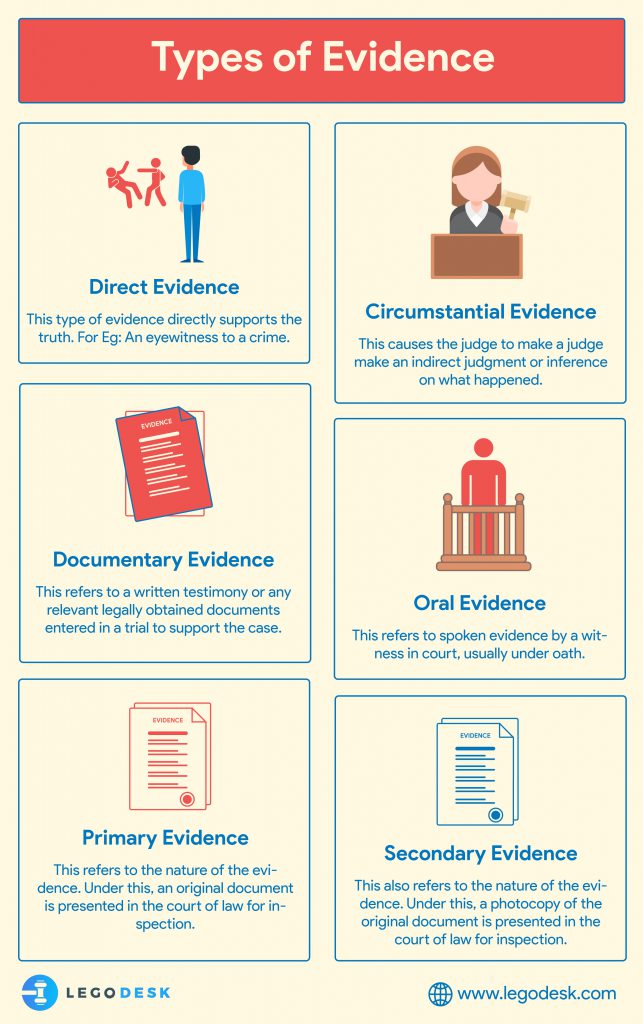Introduction
The Indian Evidence Act came into effect in the year 1872, during British Rule. This act lays down guidelines on the admissibility of evidence in the courts in India. Additionally, as under the traditional legal system, people of different social groups and communities were treated differently, which is why the enactment of this act was required. Moreover, it changed the judicial system by revolutionizing it. The Indian Evidence Act was there to ensure that all Indians were treated fairly and equally.
Read Also – Everything You Need to Know About Facts of the Case
The Objective of the Evidence Act
Evidence’ is derived from the Latin term “Evidere” which means “to show clearly, to make plainly certain, to ascertain, to prove.” However, it refers to anything that becomes necessary to prove or support a certain fact. When there is a crime, evidence plays an important role in determining who’s responsible for the criminal act and allows the investigators to review what actually happened. It is, however, important to check the authenticity of the evidence. Additionally, false, fabricated or evidence brought in by illegal means is not admissible in the court of law. However, sometimes the credibility of the evidence raises questions.
In this modern world, however, the landscape is changing every day and this is precisely why law surrounding the admissibility of evidence becomes very important. So, if there are no laws governing what can and cannot be admissible as evidence in the court of law, then anything may be passed off as such.
Therefore, the Objective of the Evidence Act India includes the following:
1) Presenting Evidence i.e. Proof to Support Facts
2) Authentication of Facts
3) Rationalizing the opinions of the Judicial Authorities
Read Also – Know Some Important Features of the Indian Evidence Act
Cardinal Principles that Emphasize the Indian Evidence Act
The Cardinal Principles that emphasize the law of evidence are –
i) Evidence should concern the matter in hand.
ii) However, hearsay evidence is not admissible.
ii) Also, the best evidence is necessary in all cases.
iv) Additionally, facts that are already known don’t fall under the purview of evidence.
v) However, facts already on the record are not evidence.
Contents of the Act
The Evidence Act India has 3 Parts, 11 Chapters, and 167 Sections.
Section 5 to Section 55 deals with Relevancy. Section 56 to Section 167 deals with Admissibility
Read Also – Everything You Need to Know About Criminal Law In India
Contents of the Indian Evidence Act, 1872:
Part I: what facts may or may not be proved? (Chapter I & II – Section 1 to 55)
- I: Preliminary
- II: Relevancy of Facts
Part II: what sort of evidence is to be given of these facts? (Chapter III & VI – Section 56 to 100)
- III: Facts Which Need Not Be Proved
- IV: Oral Evidence
- V: Documentary Evidence
- VI: Circumstances Where Documentary Evidence was Preferred Over Oral Evidence
Part III: By whom and in what manner the facts are to be proved? (Chapter VII & XI – Section 101 to 167)
- Chapter VII: Burden of Proof
- VIII: Estoppel
- IX: Witness
- X: Examination of Witnesses
- XI: Improper Admission and Rejection of Evidence
Read Also – Digital Evidence Management – DEM
Types of Evidence
Evidence may be classified into the following categories:
Direct Evidence – This type of evidence directly supports the truth. For Example- An eyewitness to a crime.
Circumstantial Evidence– This causes the judge to make a judge make an indirect judgment or inference on what happened.
Oral Evidence– This refers to spoken evidence by a witness in court, usually under oath.
Documentary Evidence– This refers to a written testimony or any relevant legally obtained documents entered in a trial to support the case.
Primary Evidence– This refers to the nature of the evidence. However, under this, a lawyer can present an original document in the court of law for inspection.
Secondary Evidence– This also refers to the nature of the evidence. Under this, a lawyer can submit a photocopy of the original document in the court of law for inspection.
Read Also – Agreement vs. Contract: Explanations And Examples

Key Concepts of the Indian Evidence Act
Some key concepts that underline the various sections and provisions of the Indian Evidence Act.
The Need for Evidence
Even the most skeptical people in the world rely only on one thing- Evidence. Additionally, the best way to help a judge reach a decision is by placing relevant proof in front of him/her.
However, evidence in the court of law can be seen as a piece of information vital to prove the truth of a matter in question or disprove something that is false. Under this, there are two types of facts. They include:
Issue of Facts– The Principal Fact of the Case
Relevant Facts– Additionally, other Relevant Interferences made in the case
Ways a Lawyer can Produce Evidence in Court
Oral Evidence- This refers to spoken evidence by a witness in court, usually under oath. Furthermore, the witness must tell the truth and nothing but the truth.
Documentary Evidence- This refers to a written testimony that can be introduced in a trial. And, it includes any relevant legally obtained documents which can help the case.
The Burden of Proving the Defendant’s Guilt
The burden of proving the defendant’s guilt is on the plaintiff and this fact must be established by them beyond a reasonable doubt in the court of law.
The three burdens of proof that the prosecution has are as follows:
- Proving the guilt of the defendant beyond a reasonable doubt
- The preponderance of the evidence
- Produce clear and convincing evidence
Authentication of Proof
It is very important to evaluate and fully authenticate the proof before it can be made admissible in the court of law. For this purpose, are five properties that a piece of evidence must have in order for it to be admissible.
Additionally, the properties are:
- The evidence is legal material
- It is Authentic
- Submitted evidence is Complete
- It must be Reliable
- And, it should be Believable
Conclusion
Therefore, it can be said that evidence plays a vital role in various litigious matters and criminal investigations. However, it is important that both parties do everything in their power to gather and produce convincing and authentic evidence to support their legal position. Moreover, once the relevant evidence is present, your legal counsel will be able to offer advice on its admissibility in the court of law and inform you of any further evidence requirement.



UDAY
September 26, 2020Very Comprehensive Article.
Should have backed with some LAND MARK verdicts of SC/HC to add a feather in the cap.
Pl. Keep it up.
Regds,
UDAY